 Global| Oct 10 2008
Global| Oct 10 2008U.S. Trade Deficit Improved Moderately
by:Tom Moeller
|in:Economy in Brief
Summary
The U.S. foreign trade deficit improved in August to an expected $59.1B. That reversed most of the m/m deterioration during July to $61.3B which was a deficit shallower than reported initially. So far this year the monthly trade [...]
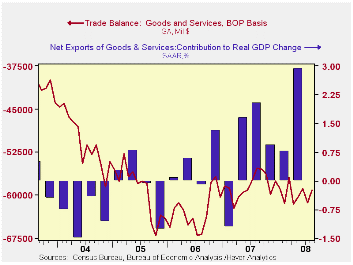
The U.S. foreign trade deficit improved in August to an expected $59.1B. That reversed most of the m/m deterioration during July to $61.3B which was a deficit shallower than reported initially. So far this year the monthly trade deficit has averaged $59.8B, slightly deeper than the $58.9B averaged during the first eight months of 2007.
Adjusted for price inflation the August trade deficit in goods improved to $39.0B from $40.9B in July. Year-to-date the real deficit has narrowed by $10.0B versus 2007 to an average $46.1B as real exports surged 10.3% and real imports fell 1.2%.
During 2Q08, a narrower trade deficit added 2.9 percentage points to real GDP growth after a 0.8 point addition during 1Q. Another addition of roughly 0.8 points is on tap for 3Q based on the recent monthly figures.
Goods exports fell by 2.4% (+19.2% y/y) during August after a
4.0% jump in July and a 4.9% June surge. Adjusted for prices, chained
dollar exports fell 0.2% (+10.9% y/y). Exports of autos & parts
plunged 13.9% (+0.6% y/y), reversing all of the July jump. Real exports
of nonauto consumer goods reversed all of the prior month's rise and
fell 6.1% (+9.7% y/y). Conversely, real exports foods, feeds &
beverages and reversed all of the July weakness. They rose 9.1% (8.7%
y/y). Real exports of capital goods increased the same 1.8% (9.8% y/y)
as during July.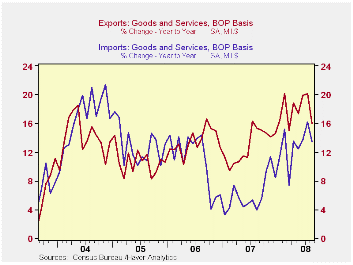
Nominal exports of services fell 0.4% (+8.0% y/y). Travel exports rose 0.4% (16.5% y/y) and passenger fares inched up 0.5% (32.9% y/y). Exports of "other" private services have deteriorated markedly to a 1.2% y/y growth rate after an 18.2% gain during all of last year.
Goods imports reversed all of their July increase and fell 3.1%, dragged down by a 14.4% decline in petroleum imports. Adjusted for lower prices, however, August petroleum imports fell a lesser 9.9% (-7.0% y/y). The average cost for a barrel of crude oil fell 3.7% during August to $120.0 (+76.0% y/y). Since then, however, average prices fell closer to $100 per barrel.
Month-to-month, imports of nonpetroleum products rose 0.9%
during August. Measured in chained 2000 dollars, nonoil imports
increased 1.4% but they fell 1.2% y/y with the slowdown in U.S.
economic growth. In chained dollars imports of capital goods reversed
all of the July increase and declined 1.9% (+1.1% y/y). Real imports of
automotive vehicles & parts continued lower and fell by 6.0%
(-14.7% y/y).Conversely, chain-price imports of nonauto consumer goods
jumped 5.6% (7.2% y/y) and rose to a record level.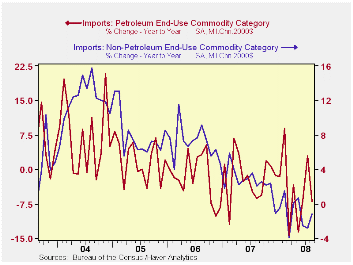
Services imports were strong again and they posted a 2.5% (9.5% y/y) increase. The overall strength was due to a 39.7% jump in royalties and license fees. Travel imports ticked up just 0.3% (5.3% y/y) and passenger fares fell 2.0% (+10.0% y/y), reversing all of the prior month's gain.
The U.S. trade deficit in goods with China was roughly steady m/m at $25.3B. The deficit with China during the first eight months of this year also was roughly steady with the first eight months of 2007. Growth in exports to China continued strong and rose 10.6% y/y but imports rose 12.0%. Import growth was even with the 11.7% y/y increase during all of 2007 but down from 18.2% growth during 2006. With Japan, the trade deficit reversed the July deterioration and moved shallower to $4.8B as exports jumped 12.8% (25.4% y/y) and imports fell another 7.0% (-7.0% y/y).
| Foreign Trade | August | July | Y/Y | 2007 | 2006 | 2005 |
|---|---|---|---|---|---|---|
| U.S. Trade Deficit | $59.1B | $61.3B | $55.3B (8/07) | $700.3 | $753.3 | $711.6B |
| Exports - Goods & Services | -2.0% | 3.3% | 15.9% | 13.0% | 13.5% | 10.6% |
| Imports - Goods & Services | -2.4% | 3.5% | 13.4% | 6.1% | 10.8% | 12.8% |
| Petroleum | -14.4% | 12.7% | 57.9% | 9.4% | 20.1% | 39.6% |
| Nonpetroleum Goods | 0.9% | 1.0% | 5.7% | 4.8% | 9.1% | 10.3% |
by Tom Moeller October 10, 2008
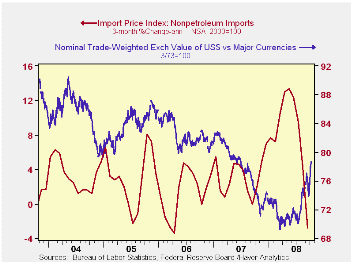
Total U.S. import prices fell slid 3.7% last month after the revised August decline of 2.6%. The September skid contrasted with expectations for a 2.5% drop.
Petroleum prices fell about as they did in August, by 9.0%. So far this month imported crude petroleum prices are down another 15% m/m.
Less petroleum, import prices fell 0.9% after a downwardly
revised 0.5% drop during August. During the last three months prices
fell at a 2.8% annual rate versus the 12-to-13% rates of positive
growth this past spring.
Growth in import prices will slow further given the recent rise in the foreign exchange value of the dollar. During the last ten years there has been a 66% (negative) correlation between the nominal trade-weighted exchange value of the US dollar vs. major currencies and the y/y change in non oil import prices. The correlation is a reduced 47% against a broader basket of currencies.
Capital goods import prices fell 0.1% for the second
consecutive month. On a three-month basis prices rose at a 0.4% annual
rate after a 5% rate of increase earlier this year. Less the lower
prices of computers, capital goods prices rose 0.2% as they did in
August. Three month growth of 4.4% was half its peak earlier this year.
Prices of computers, peripherals & accessories fell 1.1% (-7.5%
y/y) last month, about as they did during the prior three months.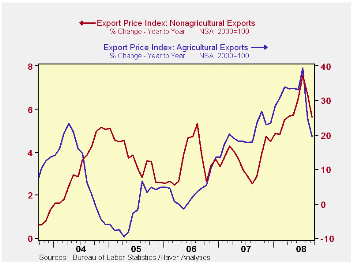
Finally, prices for nonauto consumer goods fell 0.1% and the 0.8% rate of increase during the last three months is down from the 5.9% peak earlier this year. Durable goods prices overall rose at a 1.2% rate during the last three months versus a 6.2% rate of increase earlier this year.
Total export prices fell another 1.0% due to a 0.3% (+19.5% y/y) dip in agricultural prices which followed a 9.6% August skid. Nonagricultural export prices fell hard again, last month by 0.7% (+5.6% y/y).
| Import/Export Prices (NSA, %) | September | August | Y/Y | 2007 | 2006 | 2005 |
|---|---|---|---|---|---|---|
| Import - All Commodities | -3.0 | -2.6 | 14.5 | 4.2 | 4.9 | 7.5 |
| Petroleum | -9.0 | -8.2 | 47.1 | 11.6 | 20.6 | 37.6 |
| Non-petroleum | -0.9 | -0.5 | 6.5 | 2.7 | 1.7 | 2.7 |
| Export- All Commodities | -1.0 | -1.7 | 6.8 | 4.9 | 3.6 | 3.2 |
by Robert Brusca October 10, 2008
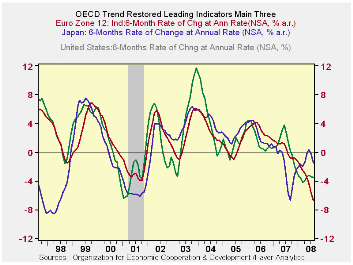
The OECD Leading Economic Indicators (trend adjusted cyclical
indicators) are continuing to show distress. They point to continuing
declines in the economies of the key OECD countries and regions. This
report is updated through August and so the side it predicts pre-dates
the financial chaos that has since gripped the markets. The OECD likes
to look at six month changes in the indices to get the ‘best signal’.
On that basis most main indicators are not only falling but the rate of
their fall is accelerating. Europe has now moved to the fore in terms
of the pace of the unraveling among major countries and regions.
| OECD Trend-restored leading Indicators | ||||
|---|---|---|---|---|
| Growth progression-SAAR | ||||
| 3-Mos | 6-Mos | 12-Mos | Yr-Ago | |
| OECD | -5.1% | -4.3% | -3.1% | 1.2% |
| OECD7 | -7.1% | -4.8% | -4.1% | 0.5% |
| OECD Europe | -10.1% | -7.7% | -4.9% | 0.4% |
| OECD Japan | -5.0% | -2.2% | -0.5% | -3.1% |
| OECD US | -4.0% | -3.0% | -4.0% | 1.8% |
| Six month readings at 6-Mo Intervals: | ||||
| Recent six | 6-Mo Ago | 12-Mo Ago | 18-Mo Ago | |
| OECD | -4.3% | -1.8% | 0.0% | 2.4% |
| OECD7 | -4.8% | -3.3% | -0.2% | 1.1% |
| OECD Europe | -7.7% | -2.0% | -0.5% | 1.3% |
| OECD Japan | -2.2% | 1.3% | -7.2% | 1.1% |
| OECD US | -3.0% | -5.0% | 2.2% | 1.5% |
| Slowdowns indicated by BOLD RED | ||||
Tom Moeller
AuthorMore in Author Profile »Prior to joining Haver Analytics in 2000, Mr. Moeller worked as the Economist at Chancellor Capital Management from 1985 to 1999. There, he developed comprehensive economic forecasts and interpreted economic data for equity and fixed income portfolio managers. Also at Chancellor, Mr. Moeller worked as an equity analyst and was responsible for researching and rating companies in the economically sensitive automobile and housing industries for investment in Chancellor’s equity portfolio. Prior to joining Chancellor, Mr. Moeller was an Economist at Citibank from 1979 to 1984. He also analyzed pricing behavior in the metals industry for the Council on Wage and Price Stability in Washington, D.C. In 1999, Mr. Moeller received the award for most accurate forecast from the Forecasters' Club of New York. From 1990 to 1992 he was President of the New York Association for Business Economists. Mr. Moeller earned an M.B.A. in Finance from Fordham University, where he graduated in 1987. He holds a Bachelor of Arts in Economics from George Washington University.






